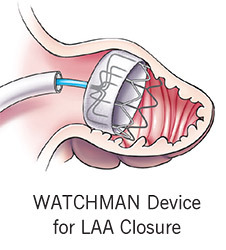What is a left atrial appendage?
The LAA is a small, ear-shaped sac in the muscle wall of the upper left chamber of the heart (left atrium). It is unclear what function, if any, the LAA performs.
If you have atrial fibrillation, your heartbeat is not normal. Blood tends to stay in the LAA and can lead to blood clots. If the blood clots travel out of the LAA, you could have a stroke.
What is LAA closure?
The LAA can be closed off with a device. This greatly reduces the risk of blood clots escaping and causing a stroke.
If you are interested in LAA closure, please talk to your doctor. You will need an evaluation by the doctors and nurses in Cleveland Clinic’s Atrial Fibrillation Stroke Prevention Center. You may be a candidate for this procedure if you:
- Have atrial fibrillation.
- Have an increased risk of stroke and systemic embolism (a blockage in one of the body’s main blood vessels).
- Should take blood-thinning medication (anticoagulants) to prevent the risk of stroke and embolism, but have an appropriate reason to choose an alternative treatment.
How is the LAA closure device put in place?

The procedure does not involve surgery, but you may have general anesthesia. The procedure is done in the electrophysiology (EP) lab. A catheter (long, thin tube) is inserted into a vein in your groin and guided up to the LAA. The device is inserted through the catheter and placed at the opening of the LAA. It expands and seals off the LAA to keep it from releasing clots.
Important information about the LAA Closure procedure:
- You will stay overnight in the hospital.
- You will have a transesophageal echocardiogram (TEE) during the procedure and again at your first follow-up appointment (45 days after the procedure).